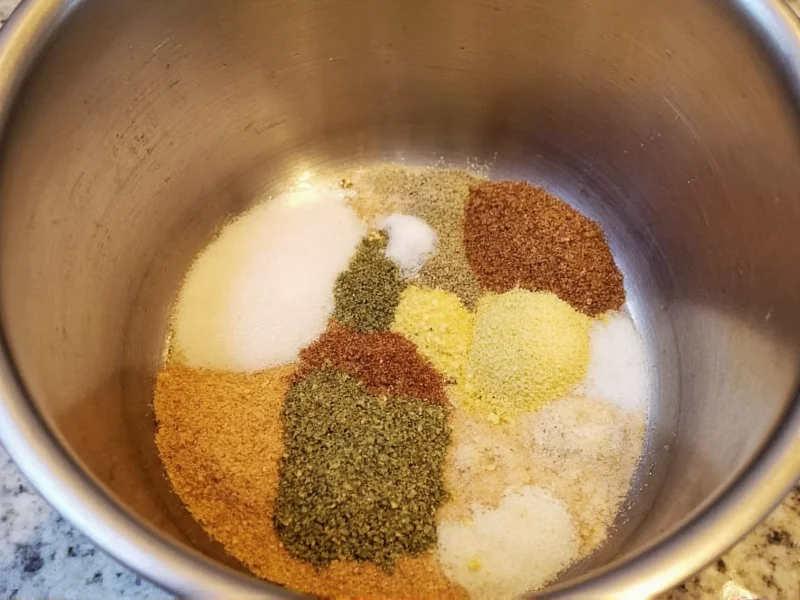Creating your own homemade creole seasoning unlocks the vibrant flavors of New Orleans cuisine without artificial additives or excessive sodium. This versatile spice blend forms the foundation of countless Southern dishes, from étouffée to grilled seafood. Unlike store-bought versions that often contain fillers, crafting your own allows complete control over ingredients and heat level.
Understanding Creole Seasoning: More Than Just a Spice Blend
Creole seasoning represents the culinary fusion of French, Spanish, African, and Caribbean influences that define New Orleans cooking. Unlike its spicier cousin cajun seasoning, authentic creole blends emphasize aromatic herbs over intense heat. The key distinction lies in the ingredient profile—creole seasoning typically contains more herbs like oregano and thyme, while cajun seasoning features higher concentrations of peppers.
| Seasoning Type | Primary Ingredients | Heat Level | Herb Content |
|---|---|---|---|
| Creole | Paprika, garlic, onion, oregano, thyme | Moderate | High |
| Cajun | Cayenne, black pepper, paprika | High | Low |
Essential Ingredients for Authentic Flavor
The magic of traditional New Orleans creole seasoning comes from the precise balance of eight core components. Each ingredient serves a specific purpose in creating the complex flavor profile:
- Paprika - Provides rich color and earthy sweetness (use Hungarian sweet paprika for authentic flavor)
- Garlic powder - Adds savory depth without burning like fresh garlic
- Onion powder - Contributes natural sweetness and umami
- Dried oregano - Brings Mediterranean herbaceous notes
- Dried thyme - Offers subtle floral undertones
- Cayenne pepper - Delivers controlled heat (adjust to taste)
- Black pepper - Adds sharp, pungent complexity
- Salt - Enhances and balances all other flavors
Step-by-Step Preparation Guide
Follow these simple steps to create professional-quality creole seasoning in minutes:
- Gather all ingredients and measuring tools - accuracy matters for balanced flavor
- Use a small glass or ceramic bowl (avoid metal which can affect flavor)
- Measure each ingredient precisely using standard measuring spoons
- Add all ingredients to the bowl in the order listed (starting with largest quantities)
- Mix thoroughly for 2-3 minutes using a small whisk or fork to ensure even distribution
- Transfer to an airtight container immediately after mixing
- Label with date and ingredients for future reference
Pro Tips for Perfect Creole Seasoning Every Time
Professional chefs and home cooks alike follow these expert techniques to maximize flavor:
- Toast dried herbs - Briefly heat oregano and thyme in a dry skillet over low heat for 30 seconds before measuring to intensify their aromatic compounds
- Sift ingredients - Pass all components through a fine mesh sieve before mixing to eliminate clumps and ensure uniform texture
- Rest period - Allow the mixed seasoning to rest for 24 hours before use, giving flavors time to meld
- Moisture control - Include a silica gel packet in your storage container to prevent clumping in humid environments
Customizing Your Homemade Creole Seasoning
One major advantage of making your own blend is the ability to tailor it to your specific preferences and dietary needs:
- For reduced sodium - Omit salt entirely and add to dishes during cooking instead
- For extra heat - Increase cayenne to 1 tablespoon or add 1 teaspoon crushed red pepper flakes
- For seafood dishes - Add 1 teaspoon celery seed for traditional Gulf Coast flavor
- For vegetarian cooking - Include 1 teaspoon smoked paprika for depth without meat-based ingredients
- For complex flavor - Add 1/2 teaspoon ground coriander for subtle citrus notes
Proper Storage for Maximum Freshness
Homemade spice blends lose potency faster than commercial versions without preservatives. Follow these storage guidelines to maintain peak flavor:
- Use dark glass or opaque containers to protect from light degradation
- Store in a cool, dry place away from stove or other heat sources
- Avoid refrigeration which introduces moisture
- Label containers with preparation date
- For longest shelf life, store in the freezer in an airtight container
Properly stored homemade creole seasoning maintains optimal flavor for 3-4 months at room temperature or 6-8 months in the freezer. Discard if you notice diminished aroma, color changes, or clumping that doesn't break apart easily.
Using Your Homemade Creole Seasoning
This versatile blend enhances countless dishes beyond traditional Louisiana cuisine. Try these professional applications:
- Rub on chicken or fish before grilling or roasting
- Stir into mayonnaise for a flavorful sandwich spread
- Add to tomato-based sauces for depth of flavor
- Mix with olive oil for a quick salad dressing
- Season roasted vegetables during the last 10 minutes of cooking
- Stir into soups and stews during the final 15 minutes of simmering
When substituting for commercial blends, use a 1:1 ratio. Remember that homemade versions lack anti-caking agents, so gently shake or stir before each use to ensure even distribution of ingredients.
Avoiding Common Homemade Seasoning Mistakes
Even experienced cooks make these frequent errors when creating homemade spice blends:
- Inconsistent measurements - Always use proper measuring spoons, not random utensils
- Using old spices - Check freshness of individual components before mixing (spices lose potency after 6-12 months)
- Improper mixing - Insufficient blending creates uneven seasoning distribution in dishes
- Exposure to moisture - Always use dry utensils when handling your seasoning blend
- Overlooking regional variations - Traditional New Orleans creole seasoning differs from other regional interpretations











 浙公网安备
33010002000092号
浙公网安备
33010002000092号 浙B2-20120091-4
浙B2-20120091-4